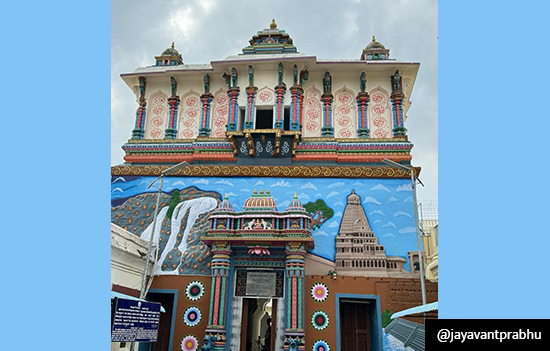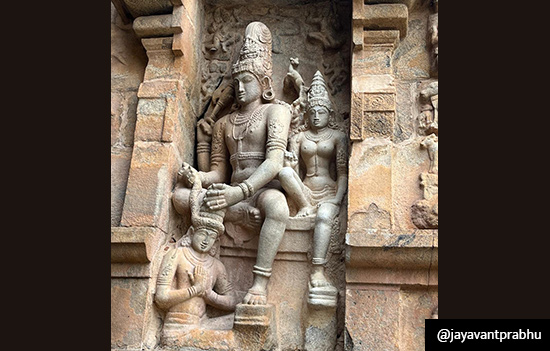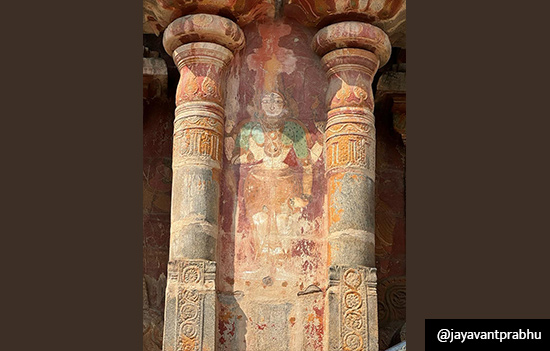- This photo feature covers Tanjore, Gangaikonacholapuram
Temple, Darasuram Mandir Kumbakonam and Maratha Palace.
Thanjavur is a good base if you wish to visit
Kumbakonam (40 kms) or Trichy (60 kms) away. It is in between the two. You can
fly into Trichy and then drive to Tanjore, Kumbakonam.
If you choose to fly into Madurai, Rameshwaram is 172
kms away and Trichy 125 kms away both in different directions. Chettinad is 87
kms away. Tanjore to Chettinad is 75 kms. They are all close by. With good
roads it does not take too long.
As a group of eight our route was Trichy, Tanjore,
Kumbakonam and Chettinad. We hired a vehicle and flew out of Trichy.
Culture Rich
Tanjore
1. The big temple of Brihadisvara at Thanjavur
Tanjore offers Chola dynasty’s living legacy in the form of three highly impressive UNESCO heritage temples. Each of these temples is an amazing confluence of religion, art, and culture.

Of these, the most famous is Brihadisvara temple
in Tanjore (also known as the periya
kovil meaning the big temple) constructed entirely in granite by Raja
Raja Chola I around 1003-1010 CE.
The huge edifice encompassed by a massive perimeter
wall (prakara), main entrance with a
monumental gateway (gopura), the main
temple tower (vimana) reaching a
lofty height of 66 metres, huge halls (mandapa)
and inner sanctum (garbhagriha) with
many sculptures of Shiva and other personalities like dwarpalakas epitomize a
fully-realized Tamil architecture-based temple.

The Vimana is taller than the Gopurams in this temple
quite in contrast with many other South Indian temples where Gopurams are
the taller structures. The tall vimana here is made with interlocking mechanism,
without any binding material and yet it has survived for centuries. The temple
is also known for its extraordinary inscriptions in elegant Tamil calligraphy
along the plinth of the vimana. These serve as the earliest recorded details of
the temple construction
The present temple complex has a few shrines built
later in the history by Pandya and Nayaka dynasties which show refinement
achieved during those periods. The Nandi Pavilion and shrines of Amman (Devi)
and Subramanyar were additions by the later rulers.
Album Brihadesvara
Temple
2. Maratha Palace, Tanjore
The Tanjore Maratha Palace, locally known as Aranmanai
Palace, was originally built by the Nayaka kings (of the Vijayanagar fame) in
1530s and later conquered by Thanjavur Marathas (Bhosales) who lived in it from
1674 to 1855.
 Arsenal tower.
Arsenal tower.
The gate to the palace has a temple like
structure which is actually an arsenal tower (Gooda Gopuram) and the gopuram is just a facade to confuse
invaders! The palace houses a seven-storey bell tower (Maada Maaligai) and a Sangeetha Mahal
with marvelous acoustic properties.
Album Maratha
Palace

The piece de resistance of the palace however is the
Art gallery. Called the Raja Raja Chola art gallery, it sports an
imposing statue of Raja Serfoji besides stunning ceilings. The bronze statues
of Nataraja Shiva, Parvati and other deities endorse the intricate
craftsmanship of yesterday years, These sculptures range from the period of CE
8th to the 18th Century . You can capture some very interesting
details here as most sculptures are well labeled and the more interesting
carvings were done during the Chola period.
Album Art Gallery
Thanjavur

The process of making Chola Bronze Statues was
revealing. Five elements- Zinc, Lead, Copper, Silver and Gold - are melted
together to produce Bronze. Figures are first made in bee wax, then covered in
clay mould before heating it at high temperature. The clay mould has a hole
below through which the wax is taken out and bronze is filled to create the
statues.
Read Bronze
making at Swamimalai, Tamil Nadu
3. Saraswathy Mahal Library
Maharaja Serfoji’s Saraswathy Mahal has a colourful façade and houses several thousand palm-leaf manuscripts and books. The content ranges from the epics of Mahabharata / Ramayana to books on anatomy and Chinese torture methods (photography is prohibited in this library).

Gangaikonda
Cholapuram (GKC)

It is located in Ariyalur district of Tamil Nadu which
is about 70 km away from Tanjore. It became the capital of Chola dynasty in
1025 CE and served as the capital for about 250 years. The temple at
GKC was built by king Rajendra Chola I ( son of Raja Raja Chola 1)
in 1035 AD after his conquests in Odisha and Bengal from where he got pots of
Ganges water to be poured in the wells of GKC temple - hence the name
Gangaikonda.
This temple shares the same design as the
Brihadeshwara Temple of Tanjore but the vimana is smaller in size
albeit with more refined architecture. The Shiva Linga in the temple
however is bigger than the one at Thanjavur temple. Thanjavur Linga is 12.5
feet tall while the Linga in GKC temple is 13.5 feet.
The main tower (vimana) of GKC temple has a graceful
upward curving form- square base, octagonal middle and circular top -
contrasting with the straight and rather sombre tower at the Tanjore
temple. The inner sanctum in GKC temple is accessed through an elegant pillared
hall guarded by a pair of monumental guardians (Dwarapalakas).
 Shiva Parvati.
Shiva Parvati.
 This is the Bhikshatana form of Lord
Shiva.
This is the Bhikshatana form of Lord
Shiva.
 Brahma.
Brahma.
The temple displays many elaborate stone
sculptures of Shiva-Parvati, dancing Nataraja , Ardhanareeshwara ( the man-woman manifestation of lord Shiva) and
Ganesha . It also has exquisite sculptures of other Hindu deities such as
Saraswati, Vishnu, Brahma and Yali.
Album Gangaikondacholapuram
Temple
Airavateswara
Temple, Darasuram near Kumbakonam
A smaller but more exquisite Airavateswara Temple built by Raja Raja Chola II in the 12th century is believed to have been named after Airavat, Lord Indra's white elephant. This temple stands in Darasuram which is about 3 km from the temple town of Kumbakonam. It follows the same Dravidian style of architecture as the temples in Tanjore and GKC but here mega size is replaced by intricate sculpture.
Before you enter the temple you cannot miss
a small structure right behind the Nandi mandapam that features
singing steps which produce musical notes when tapped on
(unfortunately caged and closed for demo now).

The main temple has a pillared hall, conceptualised as a horse-drawn chariot. The chariot being drawn by a horse, complete with ornaments, is fashioned after the ones that are taken out in the famous festivals like the Rath Yatra. The base of the pillars has Gaja Yalis with their curled trunks while the columns are ornamented with representations of stories from the epics such as the burning of Manmatha, Parvati’s penance, birth of Skanda, Shiva’s fights with the asuras and such other narrative scenes

Album Darasuram
Temple
Along with the grand sculptures, there are some
ancient murals of various deities done with vegetable dyes which
have survived centuries

To see all
albums on Tamil Nadu Temples
Albums
Temples of Kumbakonam
Albums
Navagraha Temples, all near Kumbakonam